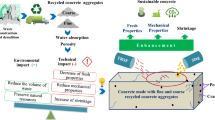Abstract
It has been estimated that around one billion tires are withdrawn from use in the world every year. Therefore, the development of new techniques for recycling waste tires is necessary. A number of innovative solutions that meet the challenge of the tire disposal problem involve using waste as an additive to cement-based materials. In this study, an experimental program was carried out to determine the compressive strength, abrasion resistance, and energy absorption capacity of rubberized concretes with and without ground granulated blast furnace slag (GGBFS). For this purpose, a water–binder ratio (0.4), four designated levels of crumb rubber (CR) contents (0, 5, 15 and 25% by fine aggregate volume), and three levels of GGBFS content (0, 20, and 40%) were considered as experimental parameters. In total, 12 concrete mixtures were cast and tested for compressive strength, abrasion resistance, and energy absorption capacity. Test results indicate that using CR aggregate decreases compressive strength and abrasion resistance of the concretes, but increases energy absorption capacity significantly.









Similar content being viewed by others
References
Zheng L, Sharon Huo X, Yuan Y (2008) Strength, modulus of elasticity, and brittleness index of rubberized concrete. J Mater Civ Eng 20(11):692–699
Wong SF, Ting SK (2009) Use of recycled rubber tires in normal and high-strength concretes. ACI Mater J 106(4):325–332
Siddiquel R, Naik TR (2004) Properties of concrete containing scrap tire rubber—an overview. Waste Manag 24(6):563–569
Cao W (2007) Study on properties of recycled tire rubber modified asphalt mixtures using dry process. Constr Build Mater 21(5):1011–1015
Yilmaz A, Degirmenci N (2009) Possibility of using waste tire rubber and fly ash with Portland cement as construction materials. Waste Manag 29(5):1541–1546
Taha MMR, El-Dieb AS, Abd El-Wahab MA, Abdel-Hameed ME (2008) Mechanical, fracture, and microstructural investigations of rubber concrete. J Mater Civ Eng 20(10):640–649
Eldin NN, Senouci AB (1993) Observations on rubberized concrete behavior. Cem Concr Aggreg 15(1):74–84
Eldin NN, Senouci AB (1993) Rubber-tire particles as concrete aggregate. J Mater Civil Eng 5(4):478–496
Topçu IB (1995) The properties of rubberized concretes. Cem Concr Res 25(2):304–310
Fattuhi NI, Clarck LA (1996) Cement-based materials containing shredded scrap truck tire rubber. Constr Build Mater 10(4):229–236
Goulias DG, Ali AH (1996) Enhancement of Portland cement concrete with tire rubber particles. In: Proceeding of 12th international conference on solid waste technology and management, Chester, Philadelphia
Li G, Zhao Y, Pang SS (1998) Three-layer built-in analytical modeling of concrete. Cem Concr Res 28(7):1057–1070
Khatib ZK, Bayomy FM (1999) Rubberized Portland cement concrete. J Mater Civ Eng 11(3):206–213
Nehdi M, Khan A, Sumner J (2005) Flexible crumb tire rubber-filled cement mortars as a protective system for buried infrastructure. J ASTM Int 2(1):1–14
Topcu IB, Avcular N (1997) Analysis of rubberized concrete as a composite material. Cem Concr Res 27(8):1135–1139
Topcu IB, Avcular N (1997) Collision behaviours of rubberized concrete. Cem Concr Res 27(12):1893–1898
Ling TCh, Nor HM, Hainin MR, Chik AA (2009) Laboratory performance of crumb rubber concrete block pavement. Int J Pavement Eng 10(5):361–374
Sukontasukkul P, Chaikaew C (2006) Properties of concrete pedestrian block mixed with crumb rubber. Constr Build Mater 20(7):450–457
Segre N, Joekes I (2000) Use of tire rubber particles and addition of cement paste. Cem Concr Res 30(9):1421–1425
Raghavan D, Huynh H, Ferraris CF (1998) Workability, mechanical properties, and chemical stability of a recycled tyre rubber filled cementitious composite. J Mater Sci 33(7):1745–1752
Li Z, Li F, Li JSL (1998) Properties of concrete incorporating rubber tyre particles. Mag Concr Res 50(4):297–304
Gesoglu M, Guneyisi E (2007) Strength development and chloride penetration in rubberized concretes with and without silica fume. Mater Struct 40(9):953–964
Guneyisi M, Gesoglu M, Ozturan T (2004) Properties of rubberized concretes containing silica fume. Cem Concr Res 34(12):2309–2317
Guneyisi E (2010) Fresh properties of self-compacting rubberized concrete incorporated with fly ash. Mater Struct. doi:10.1617/s11527-009-9564-1
Bellmann F, Stark J (2009) Activation of blast furnace slag by a new method. Cem Concr Res 39(8):644–650
Gesoglu M, Ozbay E (2007) Effects of mineral admixtures on fresh and hardened properties of self-compacting concretes: binary, ternary and quaternary systems. Mater Struct 40(9):923–937
Guneyisi E, Gesoglu M (2008) A study on durability properties of high-performance concretes incorporating high replacement levels of slag. Mater Struct 41(3):479–493
Yuksel I, Bilir T, Ozkan O (2007) Durability of concrete incorporating non-ground blast furnace slag and bottom ash as fine aggregate. Build Environ 42(7):2651–2659
ASTM C143/C143M-08 (2008) Standard test method for slump of hydraulic-cement concrete. ASTM International, West Conshohocken
ASTM C138/C138M-09 (2009) Standard test method for density (unit weight), yield, and air content (gravimetric) of concrete. ASTM International, West Conshohocken
ASTM C39/C39M-09a (2009) Standard test method for compressive strength of cylindrical concrete specimens. ASTM International, West Conshohocken
TS 2824 EN 1338 (2009) Concrete paving blocks—requirements and test methods. Turkish Standardization Organization, Ankara (in Turkish)
Lee HS, Lee H, Moon JS, Jung HW (1998) Development of tire-added latex concrete. ACI Mater J 95(4):356–364
Chung KH, Hong YK (1999) Introductory behavior of rubber concrete. J Appl Polym Sci 72(1):35–40
Turki M, Bretagne E, Rouis MJ, Quéneudec M (2009) Microstructure, physical and mechanical properties of mortar–rubber aggregates mixtures. Constr Build Mater 23(8):2715–2722
Author information
Authors and Affiliations
Corresponding author
Rights and permissions
About this article
Cite this article
Ozbay, E., Lachemi, M. & Sevim, U.K. Compressive strength, abrasion resistance and energy absorption capacity of rubberized concretes with and without slag. Mater Struct 44, 1297–1307 (2011). https://doi.org/10.1617/s11527-010-9701-x
Received:
Accepted:
Published:
Issue Date:
DOI: https://doi.org/10.1617/s11527-010-9701-x




